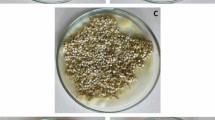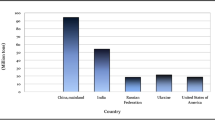Abstract
When a raw sweet potato root is analysed, only sucrose, glucose and fructose are present but during cooking, starch is hydrolysed into maltose giving the sweet flavour to cooked roots. This study aimed at developing an HPTLC protocol for the rapid quantitative determination of maltose and total sugars in four commercial varieties and to compare them to 243 hybrids grouped by flesh colour (white, orange, purple). In commercial varieties, mean maltose content varied from 10.26 to 15.60% and total sugars from 17.83 to 27.77% on fresh weight basis. Hybrids showed significant variation in maltose content within each group, with means ranging from 7.65% for white-fleshed, to 8.53% in orange- and 11.98% in purple-fleshed. Total mean sugars content was 20.24, 22.11 and 26.84% respectively for white, orange and purple flesh hybrids. No significant correlations were detected between individual sugars but maltose and total sugars content were highly correlated. Compared to the best commercial variety (Baby), 25 hybrids (10.3%) presented a higher maltose content and 40 (16.5%) showed a higher total sugars content. HPTLC was observed as an attractive, cost efficient, high-throughput technique for quantitating maltose and total sugars in sweet potatoes. Perspectives for improving sweet potato quality for consumers’ requirements are also discussed.



Similar content being viewed by others
References
Adu-Kwarteng E, Sakyi-Dawson EO, Ayernor GS, Truong VD, Shih FF, Daigle K (2014) Variability of sugars in staple-type sweet potato (Ipomoea batatas) cultivars: the effects of harvest time and storage. Int J Food Prop 17:410–420
AOAC (2002) Guidelines for single laboratory validation of chemicals methods for dietary supplements and botanicals. http://www.aoac.org/aoac_prod_imis/AOAC.../SLV_Guidelines_Dietary_Supplements.pdf. Accessed Mar 2015
Aranda MB, Vega MH, Villages RF (2005) Routine method for quantification of starch by planar chromatography (HPTLC). J Planar Chrom 16:285–289
Bernardi T, Pedrini P, Marchetti MG, Tamburini E (2015) Separation and quantitative determination of carbohydrates in microbial submerged cultures using different planar chromatography techniques (HPTLC, AMD, OPLC). J Anal Bioanal Tech 6:247. doi:10.4172/2155-98721000250
Biester A, Wood MW, Wahlin CS (1925) Carbohydrate studies 1. The relative sweetness of pure sugars. Am J Physiol 73:387–396
Bourke M (2009) Sweetpotato in Oceania, Chap 22. In: Loebenstein G, Thottappilly G (eds) The sweetpotato. Springer, Berlin, pp 489–502
Bradbury JH, Holloway WD (1988) Chemistry of tropical root crops: significance for nutrition and agriculture in the Pacific. ACIAR Monograph No 6
Champagne A, Legendre L, Lebot V (2009) Chemotype profiling to guide breeders and explore traditional selection of root crops in Vanuatu, South Pacific. J Agric Food Chem 57:10363–10370
FAOSTAT (2015) Database food and agriculture organization of the United Nations. http://www.fao.org/3/a-i4691e.pdf. Accessed Apr 2016
Grüneberg WJ, Ma D, Mwanga ROM, Carey EE, Huamani K, Diaz F, Eyzaguirre R, Guaf E, Jusuf M, Karuniawan AK et al (2015) Advances in sweetpotato breeding from 1993 to 2012. In: Low J, Nyongesa M, Quinn S, Parker M (eds) Potato and sweetpotato in Africa transforming the value chains for food and nutrition security. CABI, Wallingford, pp 1–77
Horvat RJ, Arrendale GG, Dull GW, Chapman JR, Kays SJ (1991) Volatile constituents and sugars of three diverse cultivars of sweet potatoes [Ipomoea batatas (L) Lam]. J Food Sci 56(3):714–715, 742
Kays SJ, Wang Y (2002) Sweetpotato quality: its importance, assessment and selection in breeding programs. In: Ames T (eds) Proc 1st IS on sweetpotato. Acta Hort 583, ISHS 2002, pp 187–193
Kays SJ, Wang Y, McLaurin WJ (2005) Chemical and geographical assessment of the sweetness of the cultivated sweetpotato clones of the world. J Am Soc Hort Sci 130(4):591–597
Koehler PE, Kays SJ (1991) Sweet potato flavour: quantitative and qualitative assessment of optimum sweetness. J Food Quality 14:241–249
Kumagai T, Umemura Y, Baba T, Iwanaga M (1990) The inheritance of β-amylase null in storage roots Ipomoea batatas (L) Lam. Theor Appl Genet 79:369–376
Lai YC, Huang CL, Chan CF, Lien CY, Liao WC (2013) Studies of sugar composition and starch morphology of baked sweet potatoes (Ipomoea batatas (L) Lam). J Food Sci Technol 50(6):1193–1199
Laurie SM, Faber M, Calitz FJ, Moelich EI, Muller N, Labuschagne MT (2013) The use of sensory attributes, sugar content, instrumental data and consumer acceptability in selection of sweet potato varieties. J Sci Food Agric 93(7):1610–1619
Lebot V, Ndiaye A, Malapa R (2011) Phenotypic characterization of sweet potato [Ipomoea batatas (L) Lam] genotypes in relation to prediction of chemical quality constituents by NIRS equations. Plant Breed 130(4):457–463
Lewthwaite SL, Sutton KH, Triggs CM (1997) Free sugar composition of sweetpotato cultivars after storage. New Zeal J Crop Hort Sci 25:33–41
Mcharo M, LaBonte D (2007) Genotypic variation among sweet potato clones for beta-carotene and sugar contents. In: Proceedings of the 13th Symposium of ISTRC, Tanzania, November, pp 746–754
Morlock GE, Gulnar S (2012) Comparison of two orthogonal liquid chromatographic methods for quantification of sugars in food. J Liq Chromatogr Relat Technol 34(10–11):902–919
Morrison TA, Pressey R, Kays SJ (1993) Changes in α- and β-amylase activities during storage of sweetpotato lines with varying starch hydrolysis potential. J Am Soc Hort Sci 118:236–242
Picha DH (1985) HPLC determination of sugars in raw and baked sweet potatoes. J Food Sci 50(1189–1190):1210
Shallenberger RS (1993) Taste chemistry. Blackie Academic, London
Sun YB, Severson RF, Kays SJ (1994) Effects of heating temperature and microwave pretreatment on the formation of sugars and volatiles in Jewel sweet potato. J Food Qual 14:447–456
Truong VD, Biermann CJ, Marlett JA (1986) Simple sugars, oligosaccharides and starch concentrations in raw and cooked sweet potato. J Agric Food Chem 34:421–425
Walter WM Jr, Purcell AE, Nelson AM (1975) Effects of amyolytic enzymes on “moistness” and carbohydrates changes of baked sweet potato cultivars. J Food Sci 40:793–796
Waramboi JG, Dennien S, Gidley MJ, Sopade PA (2011) Characterisation of sweetpotato from Papua New Guinea and Australia: physicochemical, pasting and gelatinisation properties. Food Chem 126:1759–1770
Wilson JE, Pole FS, Smith NEJM, Taufatofua P (1989) Sweet potato breeding. IRETA-USP Agro-Facts Publication, Western Samoa, p 39p
Woolfe JA (1992) Sweet potato, an untapped food resource. Cambridge University Press, Cambridge, p 643p
Zhang Z, Wheatley CC, Corke H (2002) Biochemical changes during the storage of sweet potato roots differing in dry matter content. Postharv Biol Technol 24:317–325
Acknowledgements
This study would not have been possible without the financial support of the Agence Nationale pour la Recherche (ANR, France, through the Project No. ANR-10-STRA-007) and the technical assistance of the Department of Agriculture and Rural Development (DARD, Vanuatu). Special thanks are due to Charles Rogers for germplasm field maintenance and to Juanita Stevens for laboratory assistance in preparing the samples and extracts.
Author information
Authors and Affiliations
Corresponding author
Ethics declarations
Conflict of interest
The author declares that there are no potential conflicts of interest.
Rights and permissions
About this article
Cite this article
Lebot, V. Rapid quantitative determination of maltose and total sugars in sweet potato (Ipomoea batatas L. [Lam.]) varieties using HPTLC. J Food Sci Technol 54, 718–726 (2017). https://doi.org/10.1007/s13197-017-2510-2
Revised:
Accepted:
Published:
Issue Date:
DOI: https://doi.org/10.1007/s13197-017-2510-2




